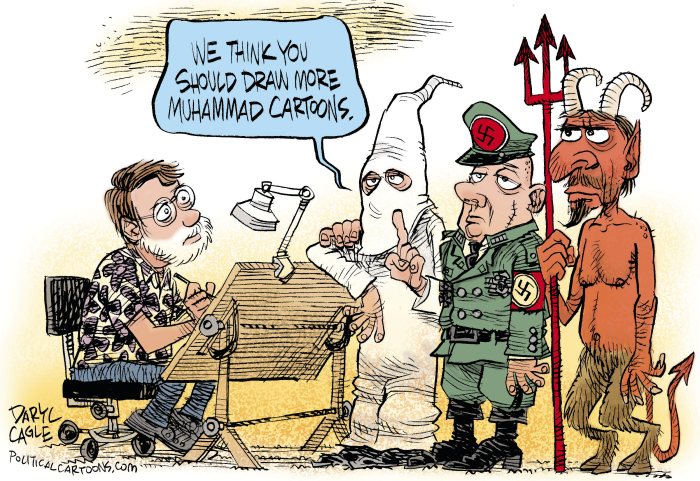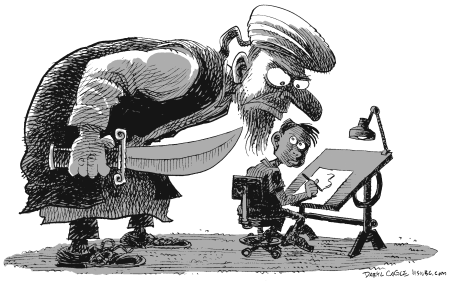We just saw yet another terror attack provoked by cartoons of the prophet Muhammad, this time at a “Draw Muhammad” cartoon contest in Garland Texas. A competent cop shot two home-grown terrorist gunmen before much damage was done. The event was organized by a right-wing group called “Stop Islamization of America” that was best known for opposing the construction of a mosque in Manhattan. The Southern Poverty Law Center lists them as a hate group, which they deny.
Cartoonist Rénald “Luz” Luzier, who drew the famous Charlie Hebdo cover after the shootings in France, recently decided he would no longer draw Muhammad cartoons. I can sympathize with Luz’s choice, since he’s now “typecast” as the premier Muhammad cartoonist – It seems reasonable that Luz wouldn’t want his career to be boiled down to being the “Muhammad cartoon guy.”
I’m an editorial cartoonist; I haven’t drawn a Muhammad cartoon myself, because I haven’t been inspired to do so. I shy away from drawing cartoons that some people would find offensive. I don’t use four letter words, or the “N-word” in my cartoons. I don’t draw sexually explicit cartoons. Offensive subject matter in cartoons can be so loud that it drowns out anything else I might want to say in a cartoon, except, “Look, I have the freedom to draw something offensive.”
Many cartoonists have drawn Muhammad cartoons, and racist cartoons, and dirty cartoons; that’s fine, that’s their business – but drawing offensive stuff just to draw attention to myself, or to prove that I have the right to do so, just looks like lousy cartooning to me. The Charlie Hebdo cartoonists were doing more than that; they were addressing issues in French culture that were important to them, and rejecting all religions that they felt didn’t fit with their secular society.
I knew three of the five Charlie Hebdo cartoonists who were murdered earlier this year and I got to know more of them at French cartoon festivals. They have a genuine passion for their issues and our conversations always turned to a discussion of their religion-bashing cartoons. Here in America we’re not faced with the same social pressures and similar cartoons here should seem out of place.
The “Stop Islamization of America” people, who sponsored this contest, are poking the extremist Islamic beast to elicit a predictable response. This violent, cartoon stimulus and response will surely continue to be repeated.
It doesn’t matter that I personally don’t choose to draw Muhammad cartoons, or that most cartoonists don’t care to draw offensive cartoons, all editorial cartoonists are now being seen as recklessly poking surly Islamic beasts. My profession is being painted with the Muhammad cartoon broad-brush.
I was recently asked to speak at a local college, and I met the college president; the first thing he said to me was, “Now, don’t show any of those Muhammad cartoons.” This is not unusual. Casual conversations with editorial cartoonists often start with, “So, do you draw those Muhammad cartoons too?”
Like Luz was typecast, it seems we’re all typecast now.




















